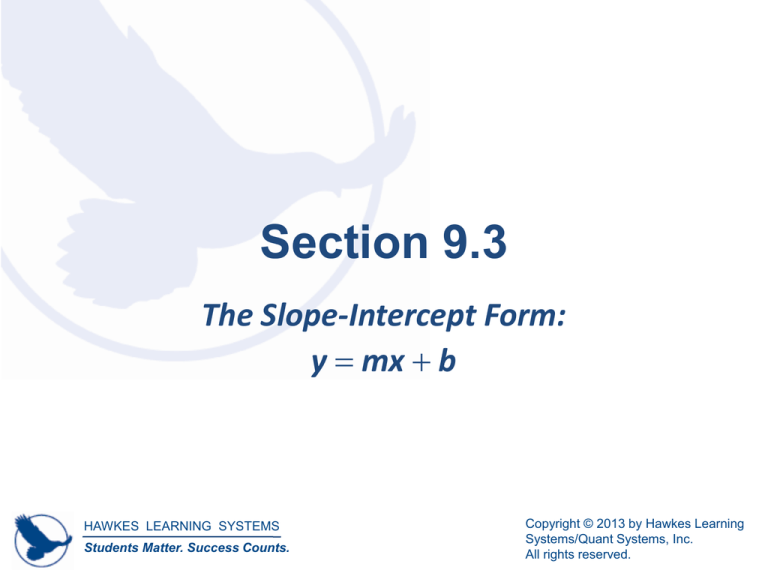
Section 9.3
The Slope-Intercept Form:
y = mx + b
HAWKES LEARNING SYSTEMS
Students Matter. Success Counts.
Copyright © 2013 by Hawkes Learning
Systems/Quant Systems, Inc.
All rights reserved.
Objectives
o Interpret the slope of a line as a rate of change.
o Calculate the slope of a line given two points that lie
on the line.
o Find the slopes of and graph horizontal and vertical
lines.
o Recognize the slope-intercept form for a linear
equation in two variables: y = mx + b.
HAWKES LEARNING SYSTEMS
Students Matter. Success Counts.
Copyright © 2013 by Hawkes Learning
Systems/Quant Systems, Inc.
All rights reserved.
Calculating the Slope
Slope
Let P1 x1 , y1 and P2 x2 , y2 be two points on a line.
The slope can be calculated as follows:
rise y2 y1
slope = m =
=
.
run x2 x1
Note: The letter m is standard notation for representing
the slope of a line.
HAWKES LEARNING SYSTEMS
Students Matter. Success Counts.
Copyright © 2013 by Hawkes Learning
Systems/Quant Systems, Inc.
All rights reserved.
Example 1: Finding the Slope of a Line
Find the slope of the line that contains the points
(1, 2) and (3, 5) and then graph the line.
Solution
y2 y1
Using 1, 2 and 3, 5 , slope = m =
x2 x1
x1 , y1
x2 , y2
52
=
3 1
3
=
4
HAWKES LEARNING SYSTEMS
Students Matter. Success Counts.
Copyright © 2013 by Hawkes Learning
Systems/Quant Systems, Inc.
All rights reserved.
Example 1: Finding the Slope of a Line (cont.)
Or, using 3, 5 and 1, 2 ,
x1 , y1
x2 , y2
y2 y1
slope = m =
x2 x1
25
=
1 3
3 3
=
=
4 4
HAWKES LEARNING SYSTEMS
Students Matter. Success Counts.
Copyright © 2013 by Hawkes Learning
Systems/Quant Systems, Inc.
All rights reserved.
Example 2: Finding the Slope of a Line
Find the slope of the line that contains the points (1, 3)
and (5, 1) and then graph the line.
Solution
Using 1, 3 and 5,1 ,
x1 , y1
x2 , y2
1
1 3 2
slope = m =
=
=
51
4
2
HAWKES LEARNING SYSTEMS
Students Matter. Success Counts.
Copyright © 2013 by Hawkes Learning
Systems/Quant Systems, Inc.
All rights reserved.
Calculating the Slope
Notes
Lines with positive slope go up (increase) as we move
along the line from left to right.
Lines with negative slope go down (decrease) as we
move along the line from left to right.
HAWKES LEARNING SYSTEMS
Students Matter. Success Counts.
Copyright © 2013 by Hawkes Learning
Systems/Quant Systems, Inc.
All rights reserved.
Slopes of Horizontal and Vertical Lines
Horizontal and Vertical Lines
The following two general statements are true for
horizontal and vertical lines.
1. For horizontal lines (of the form y = b), the slope
is 0.
2. For vertical lines (of the form x = a), the slope is
undefined.
HAWKES LEARNING SYSTEMS
Students Matter. Success Counts.
Copyright © 2013 by Hawkes Learning
Systems/Quant Systems, Inc.
All rights reserved.
Example 3: Slopes of Horizontal and
Vertical Lines
a. Find the equation and slope of the horizontal line
through the point (2, 5).
Solution
The equation is y = 5 and
the slope is 0.
HAWKES LEARNING SYSTEMS
Students Matter. Success Counts.
Copyright © 2013 by Hawkes Learning
Systems/Quant Systems, Inc.
All rights reserved.
Example 3: Slopes of Horizontal and Vertical
Lines (cont.)
b. Find the equation and slope of the vertical line
through the point (3, 2).
Solution
The equation is x = 3 and
the slope is undefined.
HAWKES LEARNING SYSTEMS
Students Matter. Success Counts.
Copyright © 2013 by Hawkes Learning
Systems/Quant Systems, Inc.
All rights reserved.
Slope-Intercept Form: y = mx + b
For y = mx + b, m is the Slope
For an equation in the form y = mx + b, the slope of the
line is m.
HAWKES LEARNING SYSTEMS
Students Matter. Success Counts.
Copyright © 2013 by Hawkes Learning
Systems/Quant Systems, Inc.
All rights reserved.
Slope-Intercept Form: y = mx + b
Slope-Intercept Form
y = mx + b is called the slope-intercept form for the
equation of a line, where m is the slope and (0, b) is
the y-intercept.
HAWKES LEARNING SYSTEMS
Students Matter. Success Counts.
Copyright © 2013 by Hawkes Learning
Systems/Quant Systems, Inc.
All rights reserved.
Example 4: Using the Form y = mx + b
a. Find the slope and y-intercept of 2x + 3y = 6 and
graph the line.
Solution
Solve for y: 2 x + 3y = 6
3y = 2 x + 6
3y 2 x 6
=
+
3
3 3
2
y = x +2
3
HAWKES LEARNING SYSTEMS
Students Matter. Success Counts.
Copyright © 2013 by Hawkes Learning
Systems/Quant Systems, Inc.
All rights reserved.
Example 4: Using the Form y = mx + b
2
Thus m = , which is the slope, and b is 2, making the
3
y-intercept equal (0, 2).
HAWKES LEARNING SYSTEMS
Students Matter. Success Counts.
Copyright © 2013 by Hawkes Learning
Systems/Quant Systems, Inc.
All rights reserved.
Example 4: Using the Form y = mx + b cont.
As shown in the graph, if we
“rise” 2 units up and “run”
3 units to the right from the yintercept (0, 2) we locate
another point (3, 4). The line
can be drawn through these
two points.
Note: As shown in the graph, we could also first “run”
3 units right and “rise” 2 units up from the y-intercept
to locate the point (3, 4) on the graph.
HAWKES LEARNING SYSTEMS
Students Matter. Success Counts.
Copyright © 2013 by Hawkes Learning
Systems/Quant Systems, Inc.
All rights reserved.
Example 4: Using the Form y = mx + b cont.
b. Find the slope and y-intercept of x + 2y = 6 and
graph the line.
Solution
Solve for y:
x + 2y = 6
2y = x 6
2y x 6
=
2
2 2
1
y = x 3
2
HAWKES LEARNING SYSTEMS
Students Matter. Success Counts.
Copyright © 2013 by Hawkes Learning
Systems/Quant Systems, Inc.
All rights reserved.
Example 4: Using the Form y = mx + b cont.
1
Thus m = , which is the slope, and b is 3, making
2
the y-intercept equal to (0,3).
1
1
We can treat m = as m =
2
2
and the “rise” as 1 and the “run”
as 2. Moving from (0, 3) as
shown in the graph on the
previous page, we locate another
point (2, 4) on the graph and
draw the line.
HAWKES LEARNING SYSTEMS
Students Matter. Success Counts.
Copyright © 2013 by Hawkes Learning
Systems/Quant Systems, Inc.
All rights reserved.
Example 4: Using the Form y = mx + b cont.
c. Find the equation of the line through the point
1
(0, 2) with slope .
2
Solution
Because the x-coordinate is 0, we know that the point
1
(0, 2) is the y-intercept. So b = 2. The slope is . So
2
1
m = . Substituting in slope-intercept form y = mx +b
2
1
gives the result: y = x 2.
2
HAWKES LEARNING SYSTEMS
Students Matter. Success Counts.
Copyright © 2013 by Hawkes Learning
Systems/Quant Systems, Inc.
All rights reserved.
Practice Problems
1. Find the slope of the line through the two points
(1, 3) and (4, 6). Graph the line.
2. Find the equation of the line through the point
1
(0, 5) with slope .
3
3. Find the slope and y-intercept for the line
2x + y = 7.
HAWKES LEARNING SYSTEMS
Students Matter. Success Counts.
Copyright © 2013 by Hawkes Learning
Systems/Quant Systems, Inc.
All rights reserved.
Practice Problems
4. Write the equation for the horizontal line through
the point (1, 3). What is the slope of this line?
5. Write the equation for the vertical line through the
point (1, 3). What is the slope of this line?
HAWKES LEARNING SYSTEMS
Students Matter. Success Counts.
Copyright © 2013 by Hawkes Learning
Systems/Quant Systems, Inc.
All rights reserved.
Practice Problem Answers
1. m = 1
1
2. y = x + 5
3
3. m = 2; y-intercept = (0, 7) 4. y = 3; slope is 0
5. x = 1; slope is undefined
HAWKES LEARNING SYSTEMS
Students Matter. Success Counts.
Copyright © 2013 by Hawkes Learning
Systems/Quant Systems, Inc.
All rights reserved.



